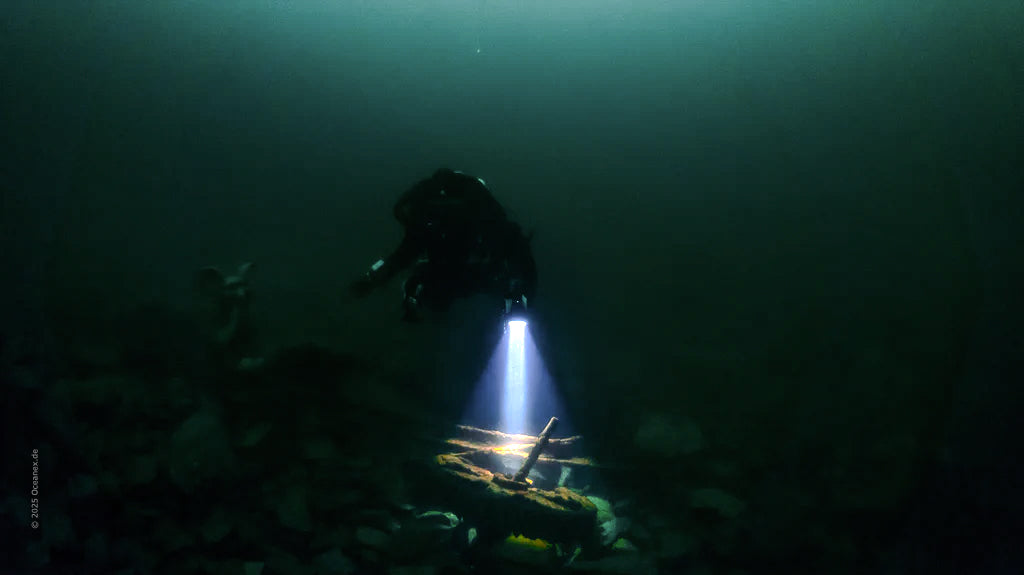
Requirements for high-end lamp systems for technical divers and differences to conventional diving lamps
Share
Divers know that the right lighting often determines the safety, efficiency and success of a dive. But there are fundamental differences between the requirements of technical divers and recreational sport divers - especially when it comes to choosing the right lamp system. While conventional diving lamps for sport divers are designed for easy handling and moderate use at depths, high-end systems for technical divers have to do much more.
What makes a dive lamp for technical divers?
Technical divers often operate in extreme environments such as caves, wrecks or depths that go far beyond what is usual for recreational divers. These demanding scenarios place specific demands on the lamp system:
Higher light output and precise light characteristics
A high-end lamp system such as the Oceanex Morph delivers up to 125,000 lux and 5500 lumens - a level that allows even large distances to be effectively illuminated in the dark. The precise light characteristics are crucial: a narrow spot (e.g. 4°) penetrates even murky water and allows clear visibility in deep environments, while an even corona illuminates the surroundings without glare. This spot to corona ratio (10:1) ensures a perfect balance between focused light and wide illumination.
Flexibility for different application scenarios
Technical diving lamps must be adaptable. The Oceanex Morph, for example, offers various reflectors (Spica and Morph) that adapt the light pattern to different requirements. Without a reflector, the lamp becomes a soft video light with a 180° beam angle , ideal for filming or illuminating larger areas.
Reliability under extreme conditions
Technical divers are often out and about for hours, sometimes in hostile environments. Absolute reliability is essential here. Lamp systems such as the Morph therefore rely on robust constructions, waterproof housings and technologies such as wear-free Hall sensor switches . The LEDs continue to function reliably even if water enters.
In professional technical or cave diving, there is no room for lamps that are not 100 percent reliable. The risk of using a lamp whose components are not designed for extreme conditions or which are of inferior quality is simply too high. Divers who rely on cheap alternatives or products that are mass-produced and not thoroughly tested are risking their lives. High-end systems such as the Oceanex Morph, which are manufactured in Germany and tested to the highest quality standards, guarantee the reliability that technical divers must rely on.
Easy to use with gloves
In cold water or when diving in caves, technical divers often wear thick gloves. High-end lamps must be designed in such a way that all functions - from adjusting the reflectors to setting the power levels - remain easy to operate.
Individual customization options
In addition to pre-programmed performance levels (e.g. 100%, 50%, 25%, 10%), high-quality systems such as the Morph offer the option of adjusting these parameters to the individual needs of the diver. This flexibility is invaluable during long and changeable dives.
How do conventional diving lamps for recreational divers differ?
Sport diving lamps are optimized for recreational applications and are therefore less powerful and specialized in many ways:
- Light output and range: With an average of 1000-2000 lumens and a shorter range, recreational diving lights provide sufficient light for clear tropical waters, but not for murky water or great depths.
- Robustness: Conventional lamps are often designed for diving depths of up to around 40 meters. Technical diving lamps, on the other hand, also work at depths beyond 100 meters and in environments with high water pressure.
- Duration of use: Recreational diving lights usually have shorter battery life and can rarely be adjusted or changed during the dive, making them unsuitable for longer and more intense dives.
- Ease of use: While sport diving lights are designed for easy operation with bare hands, they often cannot be operated with thick gloves. In addition, adjustment options for different light modes are often missing.
Conclusion
High-quality lamp systems such as the Oceanex Morph are designed for the extreme demands of technical divers. With impressive light output, flexible application options and a robust construction, they are indispensable for demanding dives in wrecks, caves or deep waters. In comparison, conventional diving lamps meet the needs of recreational divers, but quickly reach their limits in difficult conditions.
If you value safety, reliability and adaptability, high-end lamps such as the Oceanex Morph are the perfect companion for your next underwater expedition.



